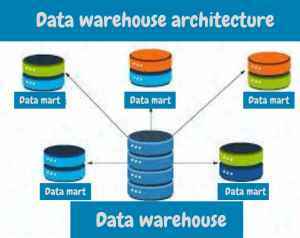Data Warehouse Architecture
What is a Data Warehouse architecture?
A data warehouse architecture plays a vital role in the data enterprise. As databases assist in storing and processing data, and data warehouses help in analyzing that data.
Data warehousing is a process of storing a large amount of data by a business or organization. The data warehouse is designed to perform large complex analytical queries on large multi-dimensional datasets in a straightforward manner. Data warehouses extract data from different resources, which are in different fonts, convert it into a unique form, and place data in Data Warehouse.
How is data stored in a Data Warehouse architecture?
Data stored in it are in the form of Summarized. It is a system that collects data from many different sources for reporting and analysis. It stores historical data about our business to analyze and extract data from it. It does not store current information or information that is updated in real-time. After entering data in the storage, it is neither changed nor removed. The only exceptions are when false or incorrect data is registered, or the its capacity exceeded.
The concept of it was introduced in 1988 by IBM researchers Barry Devlin and Paul Murphy. it uses (OLAP) Online Analytical Processing to analyze massive volumes of data rapidly. This process gives an analysis of the power to look at your data from different points of view.
It is Subject-Oriented. it is helpful in future planning. Extract data from the Dataware Warehouse is called data mining. Ad-Hoc (Queries that are not known in advance) queries are used in Data warehouses used for run-time access. it works as a central repository where information arrives from one or more data sources.
Data may be:
- Structured
- Semi-Structured
- Unstructured data
The data in the warehouses are loaded from different sources that store data in different formats and focus on various aspects of the subject. The data has to be checked, cleaned, and transformed into a united form to allow easy and fast access. The main goal of data in the it is to improve decision-making and control the enterprise’s significant subjects, such as customers. These products are organized around the work-flows of the companies. Each document in the data warehouse has some kind of time variation connected with it.
As the size of the memory grows over time (in terabytes), reloading and appending data can become a tedious and time-consuming task. Hence, rather than adhering to the typical its characteristics of keeping the data non-volatile and time-variant, new data is being added to the storage daily.
Two possible methods are as follow:
- Do hourly/daily batch updates of shadow tables or log files. Transmutation rules are performed during the loading process.
- Make real-time updates from shadow tables or log files. Again, transmutation rules are made during the loading process.
Types of Data Warehouse architecture.
There are three different types of the it. Kinds of Data Warehouse is nothing but the implementation of learning in various ways.
- Enterprise
- Operational
- Data Mart
Enterprise Data Warehouse
An enterprise provides a central repository database for decision support throughout the enterprise. It is a central place where all business information from different sources and applications are made available. Once it is stored, it can be used for analysis and used by all the people across the organization. The enterprise goal is to provide a complete overview of any particular object in the data model.
Operational Data Warehouse
These features have a sizable enterprise-wide scope, but unlike the substantial enterprise warehouse, data is refreshed in near real-time and used for routine commercial activity. It assists in obtaining data straight from the database, which also helps data transaction processing. The data present in the Operational Data Store can be scrubbed, and the duplication which is present can be reviewed and fixed by examining the corresponding market rules.
Data Mart
Data Mart may be a subset of knowledge warehouse, and it supports a specific region, business unit, or business function. Data Mart focuses on storing data for a particular functional area, and it contains a subset of data saved in a memory. Data Marts help in enhancing user responses and also reduces the volume of data for data analysis. It makes it more comfortable to go forward with the report.
Best Uses of Data Warehouses
A first data warehouse that an organization builds. This is appealing because:
- Nerve center, easy to get attention.
- In most organizations, the smallest data sets.
- Embraces all perspectives of an organization with a traditional denomination, i.e.memory.
Telecommunication
The telecommunication warehouse is denominated by the sheer volume of data generated at all, even subject areas. It stores data for 18 months. Different ways call level detail can be accommodated.
- Few months of call level detail.
- Summarizing or aggregating call level detail.
- Storing only selective call level detail.
Finance
The financial data warehouse suffers from an anomaly of inability to match balanced accounts due to many legitimate reasons. It stores data for 1+ years.
Insurance Data Warehouse
An insurance data warehouse is similar to other data warehouses but with a few exceptions.
- Store data that is very old, used for actuarial processing.
- The typical business may change dramatically over the last 40-50 years but not insurance.
- It stores data for 20-25 years.
- Transactions are not collected and treated but are in the form of a “frozen” state.
- In the Insurance environment, there are many dates of different kinds.
- It’s a very unique approach to design & implementation.
